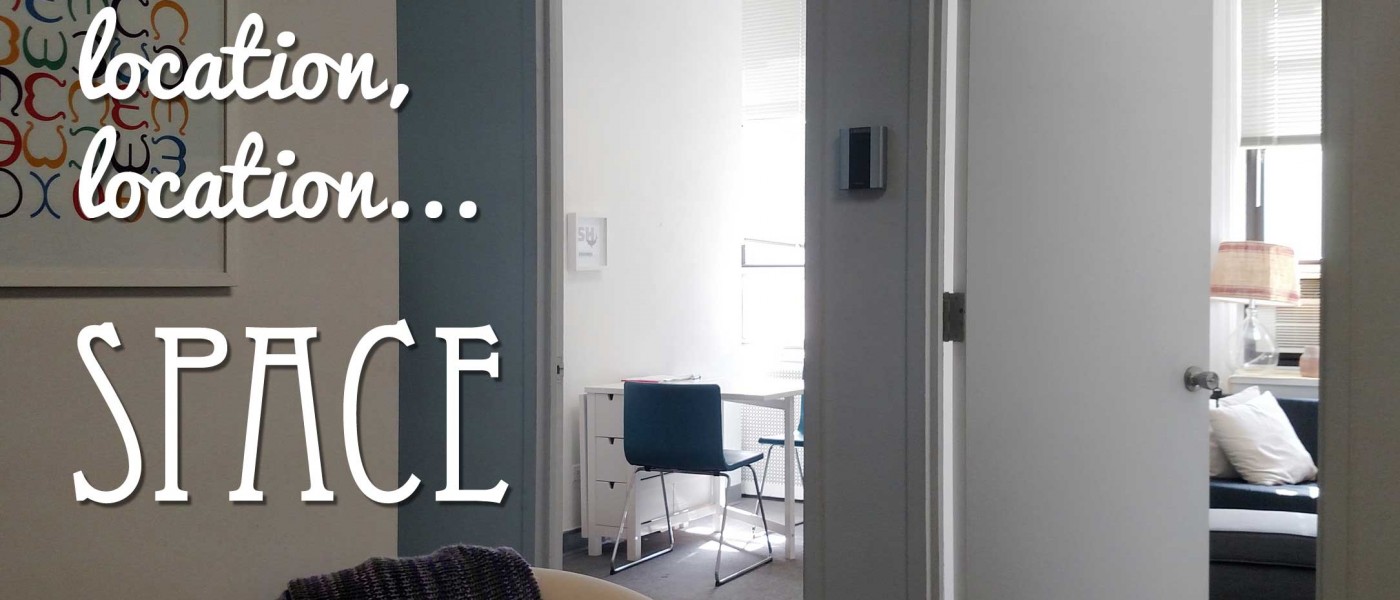5 Key Steps to Start a Speech Therapy Private Practice
I don’t pretend to know everything about the field of speech-language pathology, or every minute element of running a private speech and language therapy practice and always believe I am learning and can learn important lessons from anyone I come into contact with. That said, I have learned some important lessons in my years as a private clinician and I wanted to impart 5 of these core lessons to you. Whether you’re striking out on your own, have recently opened your doors, or have been in practice for many, these tips can be enormously useful to you and should help improve the quality of your speech therapy private practice, your marketing and the overall experience of your clients.
Secure the Ideal Space for Your Practice
I cannot underscore enough how important it is to find and develop a space that is right for your practice. I know this from a misstep of my own. I found a space in one part of New York City that, location-wise, was great. It was near multiple public transit options – very important in NYC! – and within easy striking distance of several highly populated neighborhoods. So while the location was great, the space itself wasn’t.
At the time, and as a cost-saving measure, I shared the space with a very nice social worker in part-time private practice. Since my practice is almost entirely focused on children, my ideal space would accommodate a little rough-and-tumble. After all, our work isn’t as sedentary as adult psychotherapy can be. The space contained a number of items that were quite fragile and seemingly valuable, and this being NYC, there wasn’t a ton of room to move around in. About a year into my time in the space, I had a particularly active (to say least) 3 year-old client. The circular unsecured glass table top was not ideal (also, to say the least). That’s when I resolved to find and invest in a more suitable space.
Fast forward and I really feel, after a four-month search, that I’ve found the longer term home of my practice. The space is large enough to accommodate two separate therapy tables, one for older kids, one for younger kids, as well as floor space for more active therapy strategies. It has ample storage space which is important since I continue to pile up stuff and a dedicated waiting area. I decided to take on a little extra risk by leasing a space with an extra therapy room too. While this comes with extra cost, given demand in Brooklyn Heights, my location, I’ve been able to find sub-lessees quite easily. This would also give me flexibility to have sub-contractors take on a case or two.
Finally, regarding securing your ideal space, make sure to try and negotiate a lower monthly rent. You can offer to sign a slightly longer lease in return for lower monthly rent. Or just ask – you’d be surprised what you can get if you just ask. Also, most commercial spaces are “build to suit” spaces so as long as any change would be standard, landlords tend to pay for modest renovations to suit the tenant. For example, the waiting area in my office was too large so I had the landlord erect a partition to create a smaller, more suitable waiting area and a separate work space (where I am currently writing this post from) and a storage area. Either way, don’t be shy. This is a crucial decision and you should feel right about it.
Cultivate Referral Sources
A few years ago, when I first started my private practice, I sent out a large postcard mailer to a number of local pediatric medical practices. It was all about introducing myself, my services and value proposition. Of course, not everyone I mailed postcards to became a referral source, in fact only a couple out of fifty or so solicitations did. But, one of them, a small to medium-sized pediatrics office continues to refer me patients even though I’ve moved my practice across the East River to downtown Brooklyn. In other words, if a referral source likes you, is hearing good things about the work you’ve been doing with their clients/patients, you will likely be that source’s go-to SLP.

Adapted from Cheryl Hicks’ Vintage Postcard ~ Little Girl w/Pigs
Along with this in many ways, is understanding your practice and what its specialty really is.
- Are you a pediatrics practice focusing on speech sound disorders and language all age groups, as mine is?
- Are you focused on adult language?
- Or, a more niche practice, like voice disorders or corporate communications?
I would suggest not trying to bite off more than you can chew, as they say, since each of these practice descriptions would suggest a different set of referral sources. For example, for my practice, those referral sources would be pediatricians, local private school teachers and administrators (both preschool and school-age), local public school SLPs where kids may not be eligible for services but still in need of them, and of course the parents themselves – word-of-mouth is always king! For an adult-focused clinic, I might focus more on various insurance panels, relationships with rehabilitation doctors, social workers and their facilities.
Prioritize a key referral source; take extra care to make sure they are happy and kept in the loop with the cases they refer to you.
Be Selective with your Online Marketing
Honestly, the best and most cost-effective means of building your practice’s online presence today is using Speech Buddies Connect. Speech Buddies Connect is a fast-growing network of SLPs who have created professional profiles that parents can easily search to find the best local SLPs. And if you are located anywhere in the New York City area (Brooklyn, Queens, Bronx, New Jersey), we have an expanded platform that includes free online scheduling, marketing and billing services. (In NYC, contact us directly to learn more). It only takes a few minutes to create your own profile and once you do, you instantly have your very own free online marketing resource. We are constantly working to maximize the online reach of Speech Buddies Connect, and have devoted significant resources toward this effort. The idea here is to take some of the guesswork out of an SLP’s online professional life, and to simply refer as many clients as possible, straight to you. The only onus on you is to make sure you create the best possible profile that you can; the better the profile the more likely you are to get lots of new referrals.
I personally get a new referral every other week, which for minimal effort on my part, may be my best return-on-investment of any online marketing resource I have used for my practice.
It is still possible to have a thriving private practice with no online presence, but a website is really helpful and likely worth the time, aggravation and money spent. I would say that having a website is essential. Okay, maybe this is a no-brainer. You don’t have to break the bank on your web presence nor do you need to constantly update it (though an active site is always better than a dormant one). I manage my site through virb.com, which I’ve been happy with. You pay $10 per month to have it hosted and once you’ve invested some time in setting it up, it pretty much runs itself. You can add updates whenever you like. Also, to get your site designed quickly and easily, if you aren’t a total do-it-yourself type of person, try elance.com. You can post your job, and have web designers bid on it. Expect to pay no more than $1000 to get it all set up, though this is a very vague, ballpark number (don’t quote me, please!) and the final bill could be significantly lower or higher than $1000. WordPress and Blogspot are free options that are worth considering as well.

Map at ‘Hello World!’ Kasseler Kunstverein, by Aram Bartholl
Once you have your site set up, invest some time making it work for you on the web. I’m not an expert on web marketing, so this next bit of advice is very general. Get your site listed on Google maps. This is quite easy and painless. Also, consider Google Adwords, which are the ads at the top and right side of a Google search. These cost some money and the more you budget, the more local exposure you will get. However, this ad spend should gel with the scope of your practice: if you’re part time, then perhaps AdWords is not such a great use of your money. If you have three SLPs on salary and have therapy rooms to fill and fast, then Adwords may be essential to the survival and prosperity of your practice. This is a whole other blog post, but suffice to say, successful Adwords utilization is a project all its own. As a side note, purely print-based media don’t usually have a favorable return-on-investment and should, in most cases, be avoided.
Branch Out!
I would say that the only thing I dislike about private practice, relative to when I was working on a staff, is that you often feel a bit like a “lone wolf” when you go solo. I am very lucky to have amazing associates at Speech Buddies, all with a wide array of talents; our work is always a highly collaborative process. However, from a clinical standpoint, I miss conferences with other SLPs and classroom teachers; I do honestly wish I could more easily bounce an idea off another clinician right after a session, but in private practice, the reality is that you really have to make a point to schedule time for these kinds of interactions. I will admit that given my very busy schedule (clinical work, being the Chief Scientific Officer of Speech Buddies, two young kid at home) I don’t do this enough. In fact, this was my chief work-related New Years resolution. The best way to do this is to put together an email group of colleagues in your area (they don’t have to be in private practice) and meet for coffee or dinner once every month or two. The topic need not be totally clinically focused but as a private practitioner, this regular meeting will go a long way to feeling more personally connected to other SLPs and will help keep your clinical skills sharp.
Sync Your Schedule with that of your Clients
 Now that you’re thinking of going out on your own, it’s important that you align your personal and work schedules as much as possible with that of your clients. In other words, make sure you’re available when your clients are and take time off when your clients are taking theirs. Years ago, I loved to take vacations during shoulder season for those cheaper airfares and deserted tourist sites. I remember scoring a $325 roundtrip (!) ticket from NYC to visit an old friend in London in October, 2003. If you’re working in a hospital or outpatient clinic, you tend to have flexibility to travel whenever your personal life permits. That October trip to London would never happen now; October is crunch time for me and if my clients are in the thick of the school year, then so am I. Conversely, early to mid August is much lighter for me as many of my clients are off on family vacations themselves. So, I take most of August off. The same goes for the holidays. Clinical work, especially in private practice, can be somewhat grueling. Therefore, I’d advocate taking off whenever you’re likely to get 50% of your sessions cancelled in a week. You might lose out on some business in those slow periods, but the time off really rejuvenates you and, I believe, makes you a better clinician.
Now that you’re thinking of going out on your own, it’s important that you align your personal and work schedules as much as possible with that of your clients. In other words, make sure you’re available when your clients are and take time off when your clients are taking theirs. Years ago, I loved to take vacations during shoulder season for those cheaper airfares and deserted tourist sites. I remember scoring a $325 roundtrip (!) ticket from NYC to visit an old friend in London in October, 2003. If you’re working in a hospital or outpatient clinic, you tend to have flexibility to travel whenever your personal life permits. That October trip to London would never happen now; October is crunch time for me and if my clients are in the thick of the school year, then so am I. Conversely, early to mid August is much lighter for me as many of my clients are off on family vacations themselves. So, I take most of August off. The same goes for the holidays. Clinical work, especially in private practice, can be somewhat grueling. Therefore, I’d advocate taking off whenever you’re likely to get 50% of your sessions cancelled in a week. You might lose out on some business in those slow periods, but the time off really rejuvenates you and, I believe, makes you a better clinician.
In the same vein, my practice is especially busy every day from early afternoon to early evening. I have had to make sure I can be in my office ready to see clients no matter what during these times. I can make up time for catching up on Speech Buddies work, personal stuff or spending time with my kids at other times during the week. The bottom line is that you can’t grow a practice if you’re not available when your clients are.
Best of luck to all out there who are thinking of starting a practice, or are experienced private practitioners. Working on your own, for yourself, really is extraordinarily fulfilling. However, to make it work, you have to make some adjustments. I hope this tips will help your transition to the life of private practice.




